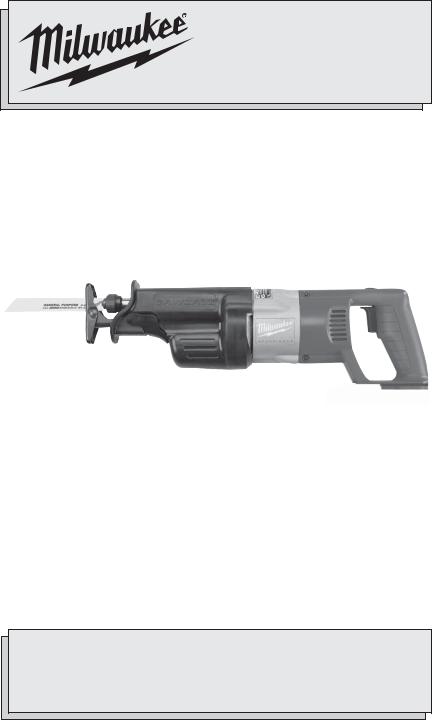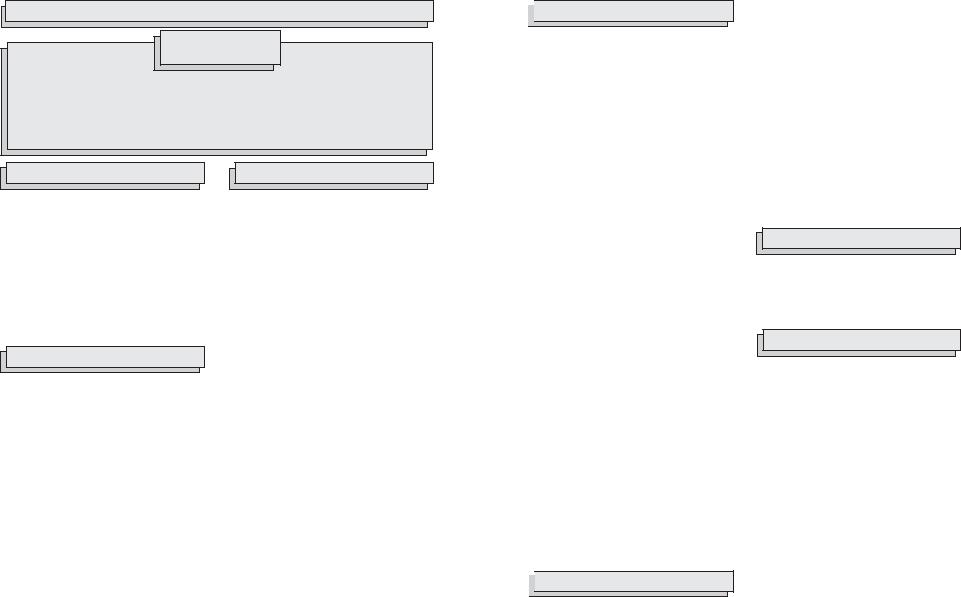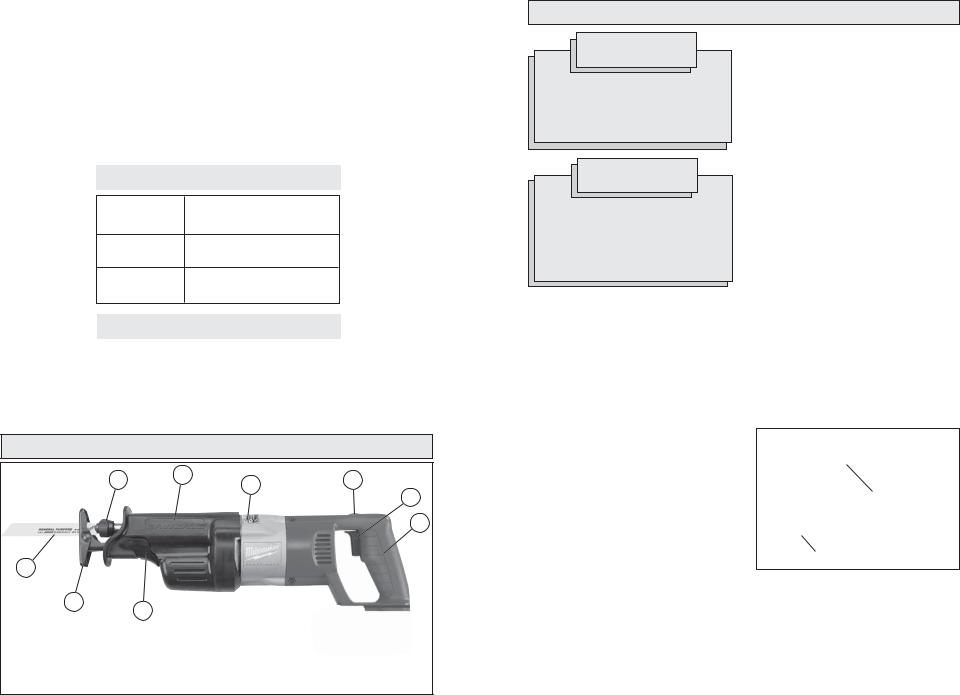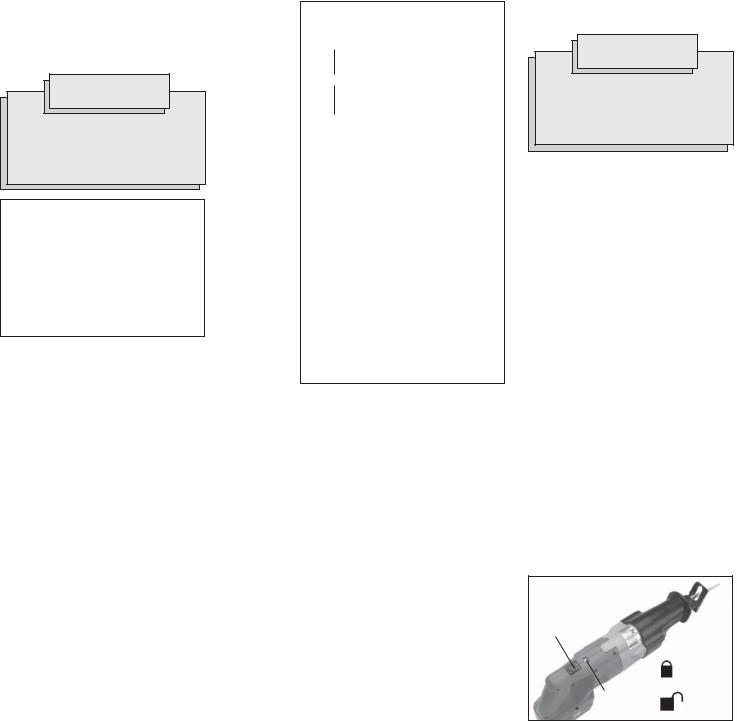Milwaukee Sawzall User Manual

OPERATOR'S MANUAL
MANUEL de L'UTILISATEUR
MANUAL del OPERADOR
Cat. No. No de cat.
6515-20
18 VOLT SAWZALL PASSE-PARTOUT SAWZALL 18 V SIERRAS SABLE-SAWZALLS DE 18V
TO REDUCE THE RISK OF INJURY, USER MUST READ OPERATOR'S MANUAL.
AFIN DE RÉDUIRE LE RISQUE DE BLESSURES, L'UTILISATEUR DOIT LIRE LE MANUEL DE L'UTILISATEUR.
PARA REDUCIR EL RIESGO DE LESIONES, EL USUARIO DEBE LEER EL MANUAL DEL OPERADOR.

GENERAL SAFETY RULES-FOR ALL BATTERY OPERATED TOOLS
WARNING
READ ALL INSTRUCTIONS
Failure to follow all instructions listed below may result in electric shock, fire and/or serious injury. The term "power tool" in all of the warnings listed below refers to your mains-operated (corded) power tool or battery-operated (cordless) power tool.
SAVE THESE INSTRUCTIONS
WORK AREA SAFETY
1.Keep work area clean and well lit.
Cluttered or dark areas invite accidents.
2.Do not operate power tools in explosive atmospheres, such as in the presence of flammable liquids, gases, or dust. Power tools create sparks which may ignite the dust or fumes.
3.Keep children and bystanders away while operating a power tool. Distractions can cause you to lose control.
ELECTRICAL SAFETY
4.Power tool plugs must match the outlet. Never modify the plug in any way. Do not use any adapter plugs with earthed (grounded) power tools.
Unmodified plugs and matching outlets will reduce risk of electric shock.
5.Avoid body contact with earthed or grounded surfaces such as pipes, radiators, ranges and refrigerators.
There is an increased risk of electric shock if your body is earthed or grounded.
6.Do not expose power tools to rain or wet conditions. Water entering a power tool will increase the risk of electric shock.
7.Do not abuse the cord. Never use the cord for carrying, pulling, or unplugging the power tool. Keep cord away from heat, oil, sharp edges, or moving parts. Damaged or entangled cords increase the risk of electric shock.
8.When operating a power tool outdoors, use an extension cord suitable for outdoor use. Use of a cord suitable for outdoor use reduces the risk of electric shock.
PERSONAL SAFETY
9.Stay alert, watch what you are doing and use common sense when operating a power tool. Do not use a power tool while you are tired or under the influence of drugs, alcohol or medication. A moment of inattention while operating power tools may result in serious personal injury.
10.Use safety equipment. Always wear eye protection. Safety equipment such as dust mask, non-skid safety shoes, hard hat, or hearing protection used for appropriate conditions will reduce personal injuries.
11.Avoid accidental starting. Ensure the switch is in the off-position before plugging in. Carrying tools with your finger on the switch or plugging in power tools that have the switch on invites accidents.
12.Remove any adjusting key or wrench before turning the power tool on. A wrench or a key left attached to a rotating part of the power tool may result in personal injury.
13.Do not overreach. Keep proper footing and balance at all times. This enables better control of the power tool in unexpected situations.
14.Dress properly. Do not wear loose clothing or jewellery. Keep your hair, clothing and gloves away from moving parts. Loose clothes, jewellery, or long hair can be caught in moving parts.
15.If devices are provided for the connection of dust extraction and collection facilities, ensure these are connected and properly used. Use of these devices can reduce dust-related hazards.

 POWER TOOL USE AND CARE
POWER TOOL USE AND CARE
16.Do not force the power tool. Use the correct power tool for your application. The correct power tool will do the job better and safer at the rate for which it was designed.
17.Do not use the power tool if the switch does not turn it on and off.Any power tool that cannot be controlled with the switch is dangerous and must be repaired.
18.Disconnect the plug from the power source and/or the battery pack from the power tool before making any adjustments, changing accessories, or storing power tools. Such preventive safety measures reduce the risk of starting the tool accidentally.
19.Store idle power tools out of the reach of children and do not allow persons unfamiliar with the power tools or these instructions to operate power tools. Power tools are dangerous in the hands of untrained users.
20.Maintain power tools. Check for misalignment or binding of moving parts, breakage of parts and any other condition that may affect the power tool's operation. If damaged, have the power tool repaired before use. Many accidents are caused by poorly maintained power tools.
21.Keep cutting tools sharp and clean.
Properly maintained cutting tools with sharp cutting edges are less likely to bind and are easier to control.
22.Use the power tool, accessories and tool bits etc., in accordance with these instructions and in the manner intended for the particular type of power tool, taking into account the working conditions and the work to be performed. Use of the power tool for operations different from those intended could result in a hazardous situation.

 BATTERY TOOL USE AND CARE
BATTERY TOOL USE AND CARE
23.Ensure the switch is in the off position before inserting battery pack.
Inserting the battery pack into power tools that have the switch on invites accidents.
24.Recharge only with the charger specified by the manufacturer. A charger that is suitable for one type of battery pack may create a risk of fire when used with another battery pack.
25.Use power tools only with specifically designated battery packs. Use of any other battery packs may create a risk of injury and fire.
26.When battery pack is not in use, keep it away from other metal objects like paper clips, coins, keys, nails, screws, or other small metal objects that can make a connection from one terminal to another. Shorting the battery terminals together may cause burns or a fire.
27.Under abusive conditions, liquid may be ejected from the battery, avoid contact. If contact accidentally occurs, flush with water. If liquid contacts eyes, additionally seek medical help. Liquid ejected from the battery may cause irritation or burns.
SERVICE
28.Have your power tool serviced by a qualified repair person using only identical replacement parts. This will ensure that the safety of the power tool is maintained.
SPECIFIC SAFETY RULES
1.Hold tools by insulated gripping surfaces when performing an operation where the cutting tool may contact hidden wiring or its own cord.
Contact with a “live” wire will make exposed metal parts of the tool “live” and shock the operator.
2.Use clamps or another practical way to secure and support the workpiece to a stable platform. Holding the work by hand or against your body leaves it unstable and may lead to loss of control.
3.Keep hands away from all cutting edges and moving parts.
4.Maintain labels and nameplates.
These carry important information. If unreadable or missing, contact a MILWAUKEE service facility for a free replacement.
2 |
3 |

5.WARNING: Some dust created by power sanding, sawing, grinding, drilling, and other construction activities contains chemicals known to cause cancer, birth defects or other reproductive harm. Some examples of these chemicals are:
•lead from lead-based paint
•crystalline silica from bricks and cement and other masonry products, and
•arsenic and chromium from chemically-treated lumber.
Your risk from these exposures varies, depending on how often you do this type of work. To reduce your exposure to these chemicals: work in a well ventilated area, and work with approved safety equipment, such as those dust masks that are specially designed to filter out microscopic particles.
Symbology
Underwriters Laboratories, Inc.,
United States and Canada
Volts Direct Current
No Load Strokes per Minute (SPM)
Specifications
Catalog |
Volts |
Length of |
Strokes |
No. |
DC |
Stroke |
per Minute |
6515-20 |
18 |
1-1/8" |
0 - 2700 |
|
|
|
|
|
FUNCTIONAL DESCRIPTION |
|
|
6 |
5 |
3 |
|
4 |
|||
|
|
2
1
7
8 |
9 |
5. |
Insulating boot |
|
|||
1. |
Handle |
6. |
Quik-Lok™ blade clamp |
2. |
Trigger |
7. |
Blade |
3. |
Trigger lock switch |
8. |
Adjustable pivot shoe |
4. |
Nameplate |
9. |
Shoe release lever |
TOOL ASSEMBLY
WARNING
Recharge only with the charger specified for the battery pack. For specific charging instructions, read the operator's manual supplied with your charger and battery pack.
 WARNING
WARNING
Always lock trigger or remove battery pack before changing or removing accessories. Only use accessories specifically recommended for this tool. Others may be hazardous.
Removing Battery Pack from Tool
To remove the battery pack, press in both battery latches and slide the battery pack off of the tool.
Inserting Battery Pack into Tool
The battery pack may feel warm after the charging cycle. If it is warm, maximize the output of the battery by allowing it to cool for a few minutes before inserting it into the tool.
Insert the battery pack by sliding battery pack onto the body of the tool. Insert the battery pack until the battery latches lock.
Selecting a Blade
The Quik-Lok® Blade Clamp can be used with all 1/2" shank universal Sawzall® blades. Use MILWAUKEE High Performance Super Sawzall® blades for best performance. When selecting a blade, choose the right type and length.
Many types of blades are available for a variety of applications: cutting metal, wood, nail-embedded wood, scroll cutting, rough- ing-in, and contours.
Many lengths are also available. Choose a length long enough to extend beyond the shoe and your work throughout the stroke.
Do not use blades less than 3-1/2" long since they won't extend beyond the shoe throughout the stroke.
For best performance and longest life, see “Accessories” to select the best blade for the job.
Installing and Removing Blades Quik-Lok® Blade Clamp
Remove battery pack before changing blades. Make sure the spindle and blade clamp areas are clean. Metal chips and sawdust may prevent the Quik-Lok® Blade Clamp from clamping securely.
. 1
Collar
Blade
1.Depending on the job, the blade may be inserted with the teeth facing up or down. To install a blade, twist collar in the direction of the arrow while inserting the blade into the clamp until the tang butts against the collar.
4 |
5 |

2.Release collar and the spring loaded mechanism will clamp the blade firmly in place.
3.Twist collar in the opposite direction of the arrow to ensure that the blade is locked into the clamp.
4.Tug on blade to make sure it is securely locked in place.
5.To remove a blade, twist collar in the direction of the arrow while pulling on the blade. Be careful when handling hot blades.
Quik-Lok® Blade Clamp Maintenance
•Periodically clean dust and debris from the Quik-Lok® Blade Clamp with dry compressed air.
•If the collar resists twisting, twist the collar back and forth to shake debris loose.
•Periodically lubricate Quik-Lok® Blade Clamp with a dry lubricant such as graphite.
Removing broken blades from the QuikLok® Blade Clamp
•Remove battery pack before removing blades.
•Broken blades can be removed by the following methods.
•Point the tool downward, twist the collar, and shake the tool up and down (DO NOT turn the tool on while your fingers are holding the blade clamp open). The shank of the broken blade should drop out of the clamp.
•If shaking the tool doesn't work...
In most cases, a corner of the broken blade will extend beyond the blade clamp. Simply twist the collar and pull the broken blade out of the clamp by this corner.
•If the broken stub doesn't extend far enough to be grabbed by its corner, use a thin blade with small teeth (such as a metal cutting blade) to hook the blade that is jammed in the clamp while twisting the collar and pull it out.
Adjusting the Pivot Shoe
The shoe can be adjusted forward or backward to six positions to take advantage of the unused portion of the blade or for special jobs requiring low blade clearance.
 WARNING
WARNING
To reduce the risk of injury, be sure the blade always extends beyond the shoe and work throughout the stroke. Blades may shatter if they impact the work or shoe (Fig. 2).
Fig. 2
1/4 Turn
1.To adjust the shoe, pull the shoe release lever down 1/4 turn and slide the shoe forward or backward to the desired position.
2.To lock the shoe in position, push the shoe release lever up.
3.After adjusting the shoe, slowly pull the trigger to be sure the blade always extends beyond the shoe and your workpiece throughout the stroke.
DO NOT OPERATE SAWZALL WITHOUT SHOE. STRIKING THE SPINDLE AGAINST WORKPIECE MAY DAMAGE THE RECIPROCATING MECHANISM.
Impact Protection System
This model is equipped with a unique patented gearing system that provides efficient power transmission and extended life in the most difficult cutting applications. This durable system will absorb impacts, blade lock ups, and motor stalls. This model can be used for extreme cutting applications such as large diameter pipe, thick metal, pallets, and heavy demolition and renovation work as well as for general purpose cutting.
Fig |
OPERATION |
|
|
 WARNING
WARNING
To reduce the risk of injury, keep hands away from the blade and other moving parts. Always wear safety goggles or glasses with side shields.
Starting, Stopping and Controlling Speed
1. To start the tool, grasp the handle firmly and pull the trigger.
2. To stop the tool, release the trigger. Allow the tool to come to a complete stop before removing the blade from a partial cut or laying the tool down.
Trigger Speed Control Switch
The SawzallTM is equipped with a trigger speed control switch. It may be operated at any speed from zero strokes per minute to full speed. Always start tool before blade contacts the workpiece. To vary the speed, simply increase or decrease the pressure on the trigger. The further the trigger is pulled, the greater the speed. To stop the tool, release the trigger and allow the tool to stop completely before removing from a partial cut or before laying the tool down.
Locking the Trigger
To lock the trigger, slide the trigger lock switch until the "locked" symbol is visible. The trigger will not work while the switch is in the locked position. Always lock the trigger and remove the battery pack before performing maintenance and changing accessories. Lock the trigger when storing the tool and when the tool is not in use.
Fig. 4
Trigger Lock
Switch
Locked
Symbols
Unlocked
6 |
7 |

General Cutting |
|
|
|
|
|
|
|
|
|
|
||
|
|
|
|
|
WARNING |
|
|
|
||||
|
|
|
|
|
|
|
|
|||||
For straight or contour cutting from an edge, |
|
|
|
|
|
|
|
|||||
|
|
|
|
|
|
|||||||
line the blade up with your cutting line. |
|
|
|
|
|
|
|
|
|
|||
Before the blade contacts the workpiece, |
|
|
|
|
|
|
|
|
|
|||
|
|
To reduce the risk of explosion, |
|
|||||||||
grasp the handle firmly and pull the trig- |
|
|
electric shock and property dam- |
|
||||||||
ger. Then guide the tool along your cutting |
|
|
age, always check the work area for |
|
||||||||
line. Always hold the shoe flat against the |
|
|
hidden gas pipes, electrical wires |
|
||||||||
workpiece to avoid excessive vibration. |
|
|
or water pipes when making blind |
|
||||||||
Cutting Metals |
|
|
|
or plunge cuts. |
|
|||||||
|
|
|
|
|
|
|
|
|
|
|||
|
1. Insert the blade into the tool. |
|||||||||||
Begin cutting at a slow speed, gradually |
||||||||||||
|
|
With the teeth facing downward, hold the |
||||||||||
increasing speed as you cut. When cutting |
|
|
||||||||||
into metals or hard materials that can not be |
|
|
tool as shown in Column A, resting the |
|||||||||
cut from an edge, drill a starting hole larger |
|
|
edge of the shoe on the workpiece. |
|||||||||
than the widest part of the blade. |
|
|
With the teeth facing upward, hold the |
|||||||||
|
|
|
|
|
tool as shown in Column B, resting the |
|||||||
Plunge Cutting |
|
|
|
edge of the shoe on the workpiece. |
||||||||
|
2. |
With the blade just above the workpiece, |
||||||||||
Your MILWAUKEE Sawzall® is ideal for |
||||||||||||
|
|
pull the trigger. Using the edge of the |
||||||||||
plunge cutting directly into surfaces that can |
|
|
||||||||||
|
|
shoe as a pivot, lower the blade into the |
||||||||||
not be cut from an edge, such as walls or |
|
|
||||||||||
|
|
workpiece, as shown. |
||||||||||
floors. Plunge cutting may be done two ways |
|
|
||||||||||
3. As the blade starts cutting, raise the |
||||||||||||
depending on how the blade is inserted. |
||||||||||||
|
|
handle of the tool slowly until the shoe |
||||||||||
Column A shows how to plunge cut with the |
|
|
||||||||||
|
|
rests firmly on the workpiece. Then |
||||||||||
teeth of the blade facing downward. (When |
|
|
||||||||||
|
|
guide the tool along the cutting line for |
||||||||||
attempting to plunge cut in this manner, shoe |
|
|
||||||||||
|
|
the desired cut. |
||||||||||
must be moved all the way out, as shown.) |
|
|
||||||||||
NOTE: To make plunge cutting easier, use |
||||||||||||
Column B shows how to plunge cut with the |
||||||||||||
a heavy gauge blade and install the blade |
||||||||||||
teeth of the blade facing upward. Do not |
||||||||||||
with the teeth facing upward as shown in |
||||||||||||
plunge cut into metal surfaces (see "Cutting |
||||||||||||
Column B. |
||||||||||||
Metals"). |
|
|||||||||||
|
|
|
|
|
|
|
|
|
|
|||
|
|
|
|
|
|
|
||||||
|
Fig. 5 |
A |
|
|
B |
|
|
|
|
|||
|
|
|
|
|
|
|
|
|
|
|
|
|
MAINTENANCE
 WARNING
WARNING
To reduce the risk of injury, always unplug the charger and remove the battery pack from the charger or tool before performing any maintenance. Never disassemble the tool, battery pack or charger. Contact a MILWAUKEE service facility for ALL repairs.
Keep your tool, battery pack and charger in good repair by adopting a regular maintenance program. After six months to one year, depending on use, return the tool, battery pack and charger to a MILWAUKEE service facility for:
•Lubrication
•Mechanical inspection and cleaning (gears, spindles, bearings, housing, etc.)
•Electrical inspection (battery pack, charger, motor)
•Testing to assure proper mechanical and electrical operation
Maintaining Tool
If the tool does not start or operate at full power with a fully charged battery pack, clean the contacts on the battery pack. If the tool still does not work properly, return the tool, charger and battery pack, to a MILWAUKEE service facility for repairs.
WARNING
To reduce the risk of personal injury and damage, never immerse your tool, battery pack or charger in liquid or allow a liquid to flow inside them.
Cleaning
Clean dust and debris from charger and tool vents. Keep tool handles clean, dry and free of oil or grease. Use only mild soap and a damp cloth to clean the tool, battery pack and charger since certain cleaning agents and solvents are harmful to plastics and other insulated parts. Some of these include gasoline, turpentine, lacquer thinner, paint thinner, chlorinated cleaning solvents, ammonia and household detergents containing ammonia. Never use flammable or combustible solvents around tools.
Repairs
For repairs, return the tool, battery pack and charger to the nearest service center listed on the back cover of this operator's manual.
ACCESSORIES
WARNING
Always remove battery pack before changing or removing accessories. Only use accessories specifically recommended for this tool. Others may be hazardous.
For a complete listing of accessories refer to your MILWAUKEE Electric Tool catalog or go on-line to www.milwaukeetool.com. To obtain a catalog, contact your local distributor or a service center listed on the back cover of this operator’s manual.
See Pages 30 & 31 for a listing of Super Sawzall® Blades.
8 |
9 |

FIVE YEAR TOOL LIMITED WARRANTY
Every MILWAUKEE electric power tool (including battery charger) is warranted to the original purchaser only to be free from defects in material and workmanship. Subject to certain exceptions, MILWAUKEE will repair or replace any part on a electric power tool which, after examination, is determined by MILWAUKEE to be defective in material or workmanship for a period of five (5) years* after the date of purchase. Return the electric power tool and a copy of proof of purchase to a MILWAUKEE factory Service/Sales Support Branch location or MILWAUKEE Authorized Service Station, freight prepaid and insured, are requested for this warranty to be effective. This warranty does not apply to damage that MILWAUKEE determines to be from repairs made or attempted by anyone other than MILWAUKEE authorized personnel, misuse, alterations, abuse, normal wear and tear, lack of maintenance, or accidents.
* The warranty period for Hoists (lever, hand chain, & electric chain hoists), all Ni-CD battery packs, Work Lights (cordless flashlights), Job Site Radios, and Trade Titan™ Industrial Work Carts is one (1) year from the date of purchase. *The warranty period for Li-Ion battery packs that do not contain V™-technology – 4.0 volts through 18.0 volts - is two (2) years from the date of purchase.
*There is a separate warranty for V™-technology Li-Ion Battery Packs V™18 volts and above that accompany V™-technology cordless power tools:
*Every MILWAUKEE V™-technology Li-Ion Battery Pack 18 volts or above is covered by an initial 1000 Charges/2 Years free replacement warranty. This means that for the earlier of the first 1000 charges or two (2) years from the date of purchase/first charge, a replacement battery will be provided to the customer for any defective battery free of charge. Thereafter, customers will also receive an additional warranty on a pro rata basis up to the earlier of the first 2000 charges or five (5) Years from the date of purchase/first charge. This means that every customer gets an additional 1000 charges or three (3) years of pro rata warranty on the V™-technology Li-Ion Battery Pack 18 volts or above depending upon the amount of use. During this additional warranty period, the customer pays for only the useable service received over and above the first 1000 Charges/2 years, based on the date of first charge and number of charges found on the battery pack via Milwaukee’s V™-technology Service Reader.
Warranty Registration is not necessary to obtain the applicable warranty on a MILWAUKEE product. However, proof of purchase in the form of a sales receipt or other information deemed sufficient by MILWAUKEE, is requested.
ACCEPTANCE OF THE EXCLUSIVE REPAIR AND REPLACEMENT REMEDIES DESCRIBED HEREIN IS A CONDITION OF THE CONTRACT FOR THE PURCHASE OF EVERY MILWAUKEE PRODUCT. IF YOU DO NOT AGREE TO THIS CONDITION, YOU SHOULD NOT PURCHASE THE PRODUCT. IN NO EVENT SHALL MILWAUKEE BE LIABLE FOR ANY INCIDENTAL, SPECIAL, CONSEQUENTIAL OR PUNITIVE DAMAGES, OR FOR ANY COSTS, ATTORNEY FEES, EXPENSES, LOSSES OR DELAYS ALLEGED TO BE AS A CONSEQUENCE OF ANY DAMAGE TO, FAILURE OF, OR DEFECT IN ANY PRODUCT INCLUDING, BUT NOT LIMITED TO, ANY CLAIMS FOR LOSS OF PROFITS. THIS WARRANTY IS EXCLUSIVE AND IN LIEU OF ALL OTHER WARRANTIES OR CONDITIONS, WRITTEN OR ORAL, EXPRESSED OR IMPLIED. WITHOUT LIMITING THE GENERALITY OF THE FOREGOING, MILWAUKEE DISCLAIMS ANY IMPLIED WARRANTY OF MERCHANTABILITY OR FITNESS FOR A PARTICULAR USE OR PURPOSE, AND ALL
OTHER WARRANTIES.
This warranty applies to product sold in the U.S.A., Canada and Mexico only.
RÈGLES GÉNÉRALES DE SÉCURITÉ POUR LES OUTILS
ALIMENTÉS PAR BATTERIE


 AVERTISSEMENT
AVERTISSEMENT
LIRE SOIGNEUSEMENT TOUTES LES INSTRUCTIONS
Le non respect des instructions ci-après peut entraîner des chocs électriques, des incendies et/ou des blessures graves. Le terme «outil électrique» figurant dans les avertissements ci-dessous renvoie à l’outil électrique à alimentation par le réseau (à cordon) ou par batterie (sans fil).
CONSERVER CES INSTRUCTIONS
SÉCURITÉ DU LIEU
DE TRAVAIL
1.Maintenirlazonedetravailpropreetbien éclairée. Les zones encombrées ou mal éclairées sont favorables aux accidents.
2.Ne pas utiliser d’outil électrique dans une atmosphère explosive, telle qu’en en présence de liquides, de gaz ou de poussières inflammables.
Les outils électriques génèrent des étincelles qui peuvent enflammer les poussières ou les fumées.
3.Tenir les enfants et les personnes non autorisées à l’écart pendant le fonctionnement d’un outil électrique.
Unmanqued’attentiondel’opérateurrisque de lui faire perdre le contrôle de l’outil.
SÉCURITÉ ÉLECTRIQUE
4.La fiche de l’outil électrique doit correspondre à la prise d’alimentation. Ne jamais modifier la fiche d’une manière quelconque. Ne pas utiliser d’adaptateur avec les outils électriques mis à la terre (à la masse).
Des fiches non modifiées et des prises d’alimentation assorties réduisent le risque de choc électrique.
5.Éviter tout contact corporel avec des surfaces reliées à la masse ou à la terre telles que tuyaux, radiateurs, cuisinières et réfrigérateurs. Un risque de choc électrique plus élevé existe si le corps est relié à la masse ou à la terre.
6.Ne pas exposer les outils électriques à la pluie ou à l’humidité. Le risque de choc électrique augmente si de l’eau s’infiltre dans un outil électrique.
7.Prendre soin du cordon. Ne jamais utiliser le cordon pour transporter, tirer ou débrancher l’outil électrique. Tenir le cordon à l’écart de la chaleur, des huiles, des arêtes coupantes ou des pièces en mouvement. Un cordon endommagé ou emmêlé présente un risque accru de choc électrique.
8.Se procurer un cordon d’alimentation approprié en cas d’utilisation d’un outil électrique à l’extérieur.
L’utilisation d’un cordon d’alimentation pour usage extérieur réduit le risque de choc électrique.
SÉCURITÉ INDIVIDUELLE
9.Être sur ses gardes, être attentif et faire preuve de bon sens en utilisant un outil électrique. Ne pas utiliser un outil électrique en cas de fatigue ou sous l’influence de drogues, d’alcool ou de médicaments. Un instant d’inattention lors de l’utilisation d’un outil électrique peut entraîner des blessures graves.
10.Utiliser un équipement de sécurité. Toujours porter des lunettes de protection. Un équipement de sécurité comprenant masque anti-poussière, chaussures de sécurité anti-dérapantes, casque ou dispositif de protection antibruit peut, dans les circonstances appropriées, réduire le risque de blessure.
11.Éviter tout démarrage accidentel de l’outil. S’assurer que le commutateur est en position OFF (Arrêt) avant de brancher l’outil. Le port de l’outil avec un doigt sur le commutateur ou son branchement avec le commutateur en position ON (Marche) sont favorables aux accidents.
10 |
11 |
